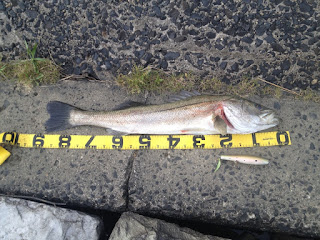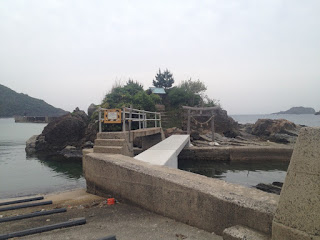At last I did it! I finally caught a Japanese sea bass with the Guppy Lure’s 2 oz. Mini. I have declared my love for American pencil poppers several times in this blog. I love how American surf fishermen use them. Their method is completely different from Japanese fishermen’s, and I may be one and only practitioner of the method in Japan (If you are unfamiliar with the method, see my previous post No. 268). I own several American pencil poppers and I love all of them, but I feel a special attachment for Guppy Lure’s plugs. Two years ago I found a defect in one of them. I noticed that the weight inside my 2 oz. Mini was loose. I contacted the maker, and they immediately dealt with the matter and sent a replacement all the way to Japan. I was impressed with their professionalism and pride, and I had since wanted to catch a Japanese sea bass with one of their lures. This evening I finally did it. It was a fat beautiful fish of 75 cm (30 in.) long. I finally carried out my promise.
(ついにやりました! グッピールアーの2オンス・ミニを使って、ついにスズキを釣ったのです。私はこれまでにも数回、このブログにおいて、アメリカのペンシル・ポッパーに対する愛を宣言してきました。私は、アメリカの岸釣り師たちのペンシル・ポッパーの使い方が大好きなのです。彼らの使い方は、日本の釣り師の使い方とは全く異なるのですが、彼らの使い方を日本で実践しているのは、もしかすると私だけなのかもしれません(もしその使い方に馴染みがなければ、以前の投稿No. 268を御覧ください)。私はアメリカのペンシル・ポッパーをいくつか所有しており、その全てが大好きなのですが、グッピールアーのプラグにはとりわけ愛着を感じています。2年前、私は、それらのプラグの一つに欠陥があることに気づいたのです。2オンス・ミニの内部にあるオモリが固定されていなかったのでした。製作者に連絡すると、彼らはすぐに問題に対処し、代用品をわざわざ日本まで送ってくれたのです。私は彼らの職人気質とプライドに感銘を受け、以来、彼らのルアーを使ってどうしてもスズキを釣りたいと考えてきました。今夕、私はついにそれを成し遂げました。75センチの、よく太った美しいスズキです。私はやっと、約束を果たしたのです。)




























